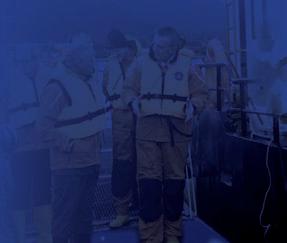
6 minute read
Technology






FIVE stars

A shellfi sh producer in Dorset is helping to assess the potential of 5G telecoms
BY ROBERT OUTRAM

Below: Richard Pricke� ; Digby Sowerby Below right & Opposite: Jurassic Sea Farms crew This year, Dorset in the south west of England will be the se� ng for a ground-breaking project aimed at exploring how 5G telecommunica� ons can transform food produc� on. The 5G RuralDorset project, led by Dorset Council and part-funded by the Department for Digital, Culture, Media and Sport’s 5G Testbeds and Trials Programme, is aimed at understanding how next genera� on connec� vity can help rural communi� es. The project is one of a half dozen industry-focused ini� a� ves throughout the UK, and the largest within the agriculture and aquaculture sectors.
Understanding how 5G can be used to address specifi c challenges in food produc� on is a key research area within the project. The agriculture and aquaculture trials, led by Wessex Internet, involve farms from across the county, including two large arable farms in North Dorset, a mixed farm at Kingston Maurward College – and Jurassic Sea Farms, which grows shellfi sh and seaweed in a site in Portland Harbour.
Digby Sowerby, Wessex Internet Project Manager for the 5G Rural Dorset project, describes the ini� a� ve as an “accelerator project”. As he explains, investment in state of the art equipment and end-user hardware for 5G is expensive, especially as it is not yet in mass produc� on. Government funding makes it possible to iden� fy and test applica� ons and assess which might deliver prac� cal benefi ts.
He says: “Our aim is to deliver a 5G system that is reliable, aff ordable and interoperable [working across diff erent systems].”
As Digby Sowerby explains, there are three main “types” of 5G: low frequency, which will give good public coverage even for remote areas; high frequency communica� ons using private installa� ons, capable of transmi� ng large amounts of visual and other data easily; and a very high frequency that can transmit massive amounts of data in a small area, up to 200 metres.
Rural areas typically have patchy 3G or 4G coverage at best, so farmers on land or sea have a problem when using new technology – like drones, robots or monitoring equipment – because data has to be transferred physically rather than transmi� ed wirelessly. The 5G revolu� on could change all that.
Jurassic Sea Farms (originally the Dorset Seaweed Company) was formed in 2018 by Na� ve









Marine Centre (NMC) and Hugh Wiltshire. Nigel Bloxham, owner of the Crab House Cafe and oyster farm, also became an investor in 2019.
Richard Pricke� , a director with Jurassic Sea Farms, says their 5G project will focus on two main applica� ons: measuring and monitoring key parameters, and introducing an underwater camera system.
Pricke� says: “We have got a remote site which you need to monitor in a number of ways, and as easily as possible.”
Remote monitoring reduces � me and costs, he adds. Key parameters are likely to include dissolved oxygen levels, chlorophyll and water temperature. On the la� er, the farm has a specifi c responsibility to report to the regulator, Natural England, if the sea temperature rises above 20C. This is because the main shellfi sh crop consists of Pacifi c oysters, a non-na� ve species, which are more likely to spawn above that temperature – although the Jurassic Sea Farms oysters should all be sterile, triploid oysters the precau� on is s� ll necessary.
He adds: “Using a camera will help us to see how fast the seaweed is growing, to op� mise cropping.”
Jurassic grows two na� ve kelp species, using seeded lines. Combining the seaweed farm with growing oysters is a mul� -trophic approach that should enhance produc� on for both.
Another use for the camera will be monitoring predators, whether for the seaweed or the shellfi sh. Portland Harbour is home to dolphins and many larger fi sh species. 5G communica� ons, it is hoped, will mean that key data can be transmi� ed directly to the farm staff without frequent trips out to the site itself.
Other trials within the project include using drones which can transmit data directly to the farmer, a monitoring system using tags and cameras to monitor the health of cows and a wheat farm run by robots. As Mar� n Sutcliff e, Aquaculture and Fisheries Offi cer with the Dorset Coast Forum, puts it: “Whatever comes out of the 5G project has to make life easier for the farmers.” FF



Post your vacancy on www.fi shfarmermagazine.com for only £199 (+vat) per job posting.



Fish Farmer


Coming in the next issue...




FEBRUARY ISSUE • Sea lice • Land-based Farming and Hatcheries • Anti-fouling and Disinfection • Management, Monitoring, Testing & Analysis

For more information on opportunities for advertising with editorial content around these subjects please contact: Janice Johnston 0044 (0) 131 551 7925 jjohnston@fi shfarmermagazine.com


Copy deadline - Friday 29 Janaury Fish Farmer











